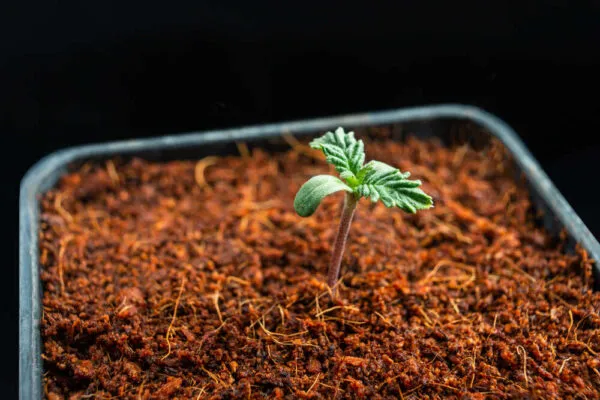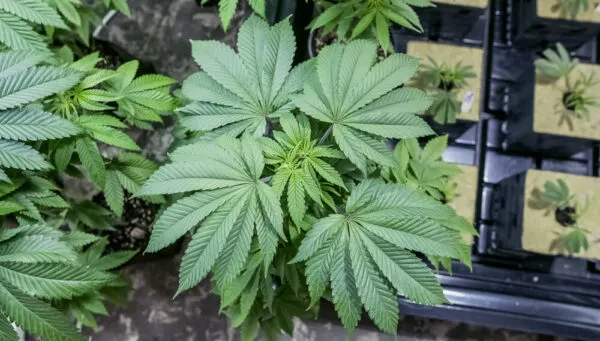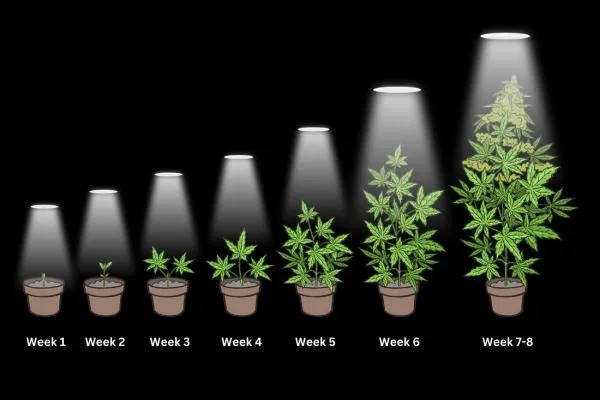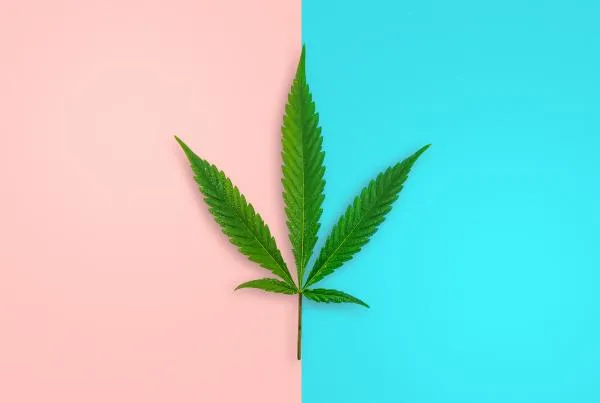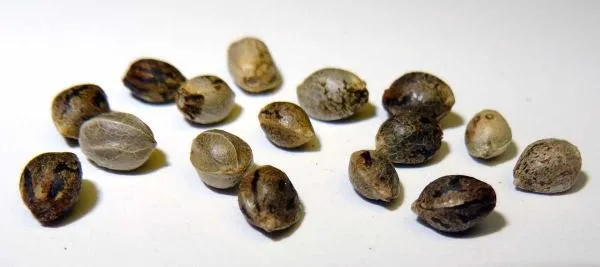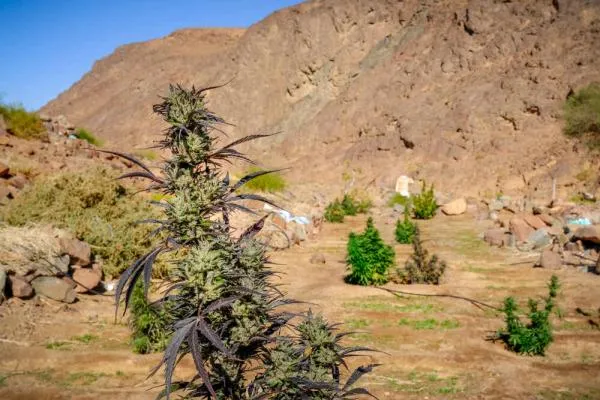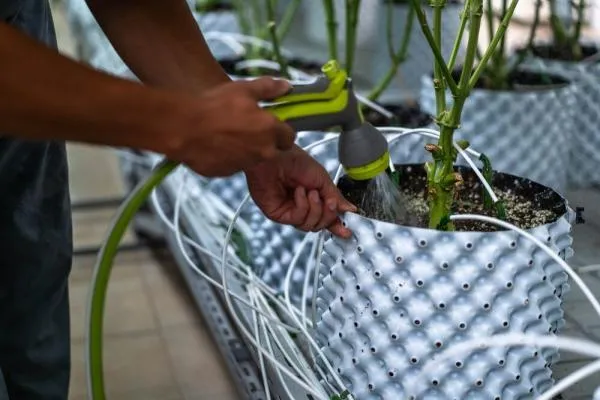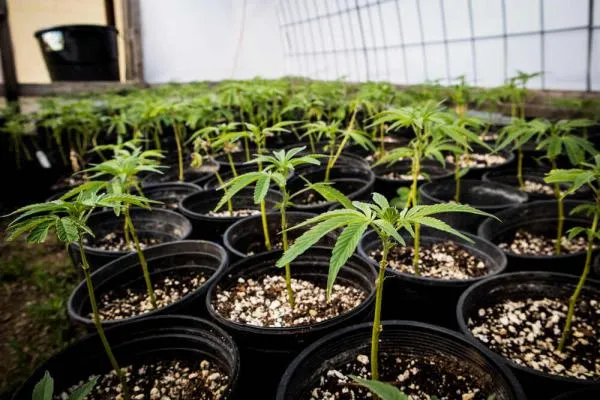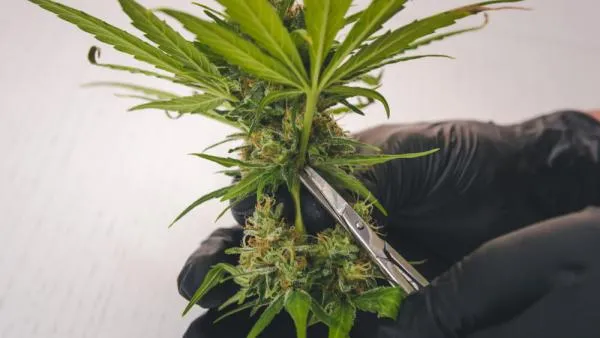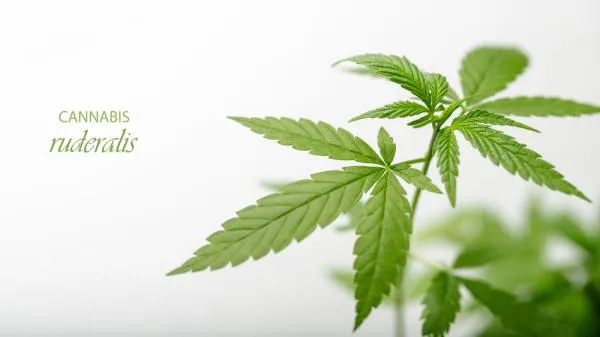So, you’ve made the decision to start growing your own cannabis, purchased all the right gear for your garden and stocked up on some quality genetics. Once you have successfully germinated your seeds, the next hurdle to overcome is surviving the cannabis seedling stage.
As the more experienced growers know, many things can happen during a plant’s lifetime that can either diminish a harvest or, worse yet, completely ruin your crop. The cannabis seedling stage is no different and is the period when a plant is at its most delicate. During the seedling stage cannabis plants require special attention and care to survive and make it to the vegetative stage in good health. So, lets take a look at how you get them started properly, and how to avoid any mishaps along the way.
When does the seedling stage start?
This seems rather obvious, but for those out of the loop on basic plant biology, the seedling stage of any plant begins of course with germination. There are multiple ways of germinating seeds and starting the seedling stage, though the two most popular are placing seeds between two wet paper towels (or into some other type of saturated material such as cotton) and then onto a plate or other container sealed with plastic (so as to prevent evaporation of moisture) until the taproot emerges. This process usually takes 24-72 hours. Once tap root emerges the newborn seedlings can be transferred to a proper growing medium.
The other method is to place ungerminated seeds directly into the ground or growing medium at a shallow depth (about ¼ inch/0.5 cm), making sure the medium remains moist. Once they’ve sprouted, you are now officially in the cannabis seedling growth stage! However, there still is plenty to do to make sure your healthy seedlings don’t take a wrong turn early on.
Choosing the correct soil and pots

What is the best soil or medium for seedlings?
Depending on how you start your seedlings (small pots, jiffies, rockwool cubes, etc.), you will have to take into account the medium they will be in before they find a permanent home, provided of course you don’t plant in place right away (which is recommended for autoflowers). Seedlings in general are very sensitive and should be handled with extra care so as not to damage or stress them out, which could negatively impact their growth.
The most important factor to consider at this stage is having a well-aerated, properly-draining medium so that water can drain freely and oxygen can reach the roots. By having something like perlite or vermiculite blended into the medium, you allow moisture to drain and keep the seedling from suffocating.
One thing to avoid at this stage is putting seedlings in a heavily fertilized grow medium. If the medium is too rich and nutrient-dense, this can quickly lead to nutrient burn and/or lockout, thus preventing your seedlings from getting the necessary sustenance for growth.
What are the best pots for growing cannabis seeds?
Regarding the best type of pot for growing healthy seedlings, it is up to the grower to decide which pots suit their needs the best. Fabric pots are generally recommended as a superior material for pots, because they are breathable. This prevents over watering, water from stagnating in the root zone and it allows the roots of the plant to breath better.
In terms of the pot size, that all depends on whether you plan on transplanting your seedlings. If using starter pots, jiffy disks, etc. you can start out with small containers (8 oz/ 0.25 l) for the first week or so, then doubling the pot size afterwards for another 10-20 days. You can progressively increase the pot size even further but remember that transplanting is very stressful to your plant so it’s best to keep the number of transplants to a minimum.
One thing to remember with respect to pot size, make sure that your roots have enough space to grow out, otherwise they will become root-bound and potentially wilt, giving you the impression that they require more water. If using a plastic pot, make sure there are plenty of drainage holes so that water doesn’t collect in the soil, which could lead to fungal, bacterial and pest attacks.
Pro-tip: If starting your marijuana seeds in jiffy disks or other small containers, you can transplant after about 10 days directly to the plant’s final destination as the bigger pot will support faster growth and the plant won’t be as stressed.
What pots should you use for autoflower seeds?
In this regard, it is recommended to put autoflowering seeds into the final pot straight from germination. This is because have a much lower tolerance for stress as well as a shorter timeframe for recovery than when growing with photoperiod cannabis seeds. Since autoflowers generally don’t get as big as photoperiod varieties, a pot size of up to 4 gallons (15 l) should be plenty.
Creating the perfect climate for your seedlings
During the seedling stage, plants do require attention, though not as much as fully vegging ones. Seedlings are quite adaptable and quickly grow into vigorous plants, however if you want to make life easier for your garden and want to guarantee healthy seedlings, there are three crucial factors to consider, specifically:
- Temperature – Much like adult plants, seedlings prefer a nice, temperate daytime climate of around 68-77°F (20-25°C) and slightly cooler at night, roughly 60-66°F (16-20°C). High temperatures should be avoided as heat stress can very quickly kill your seedlings, especially with low humidity. On the other end of the spectrum, colder temperatures will significantly stunt growth as water and nutrients aren’t able to move as quickly to where they need to be. This can be noticed by weak/frail looking seedlings that can’t seem to grow at all.
- Humidity – This is another area where cannabis seedlings can be vulnerable if you are not too careful. If the humidity is too high, seedlings can be affected by stem rot, which is a fungal attack that occurs if the medium is too wet, and oxygen does not reach the roots. Seedlings get their moisture through their leaves so there is no need to overdo with watering. If not humid enough, seedlings will have stunted growth and will display symptoms similar to those of nutrient deficiencies. If too humid, fungal and pathogen attacks as well as pests can occur. A relative humidity level between 40-60% is ideal.
- Light –Just how much light do marijuana seedlings need? Just like with nutrients, seedlings do not need all that much for the short time they are in the seedling stage, though that doesn’t mean lighting can be neglected. If they don’t get enough light, seedlings will stretch towards a light source becoming long and slender and as a result, top-heavy. This can be remedied by propping them up with a toothpick, skewer or small wooden stakes. If starting seedlings indoors, bringing the light source a little closer will also help stabilize them. Since seedlings are quite delicate and sensitive, this means that artificial lighting should not be too strong, otherwise the young, small leaves can get quickly burnt. Fluorescent lamps/bulbs (T-8 / T-5 or CFLs) placed at around 6 inches (15 cm) above the canopy should provide enough light for a couple of weeks before the vegetative phase starts and since they do not generate as much heat as HID lamps, they won’t get too hot for your seedlings. While some growers use a 24-hour light cycle for seedlings, a shorter light cycle (no more than 18 hours) is recommended as it gives your baby plants some time to rest and recover.
Watering and feeding your seedlings
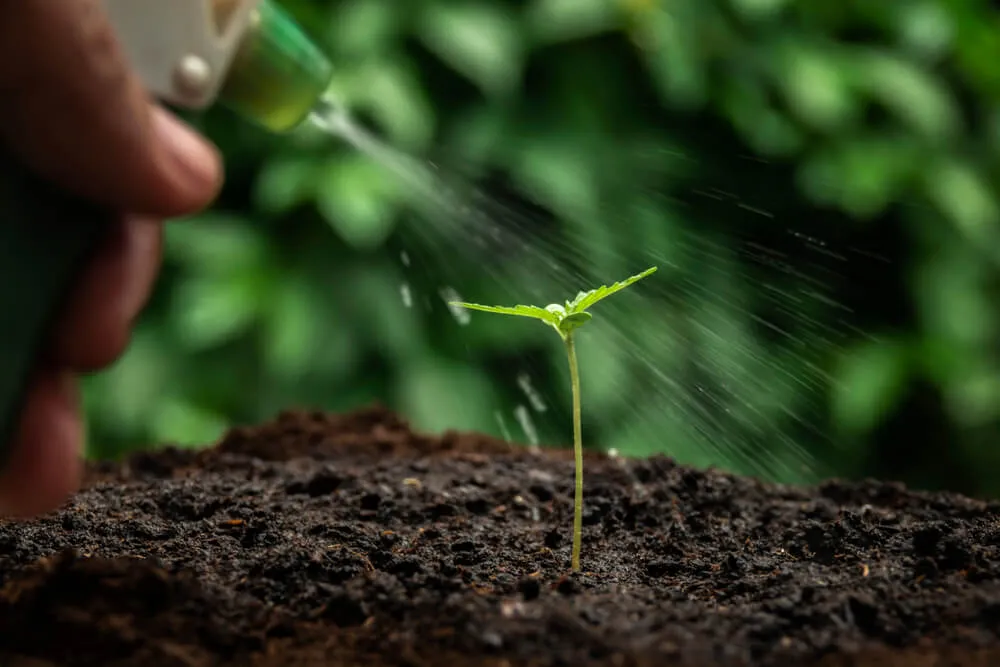
How often should I water seedlings?
Simply put, whenever they need it, though not too often. By overwatering them you run the risk of fungal attacks or depriving the seedling of precious oxygen. Many newbie growers make this mistake, as is often the case with overfertilization, thinking that more is better and that the plant will somehow manage on its own.
Depending on the medium you are growing with, if it is very fine it will hold a lot of water but not a lot of oxygen so here you have to be conservative with watering. If your soil is more porous (i.e., drains quickly), you will have to water it a little more often. At any rate, you should regularly check up on your seedlings and assess the medium by hand. If the top level (about an inch or so) is completely dry, then you can add a bit of water, ideally as close to the root ball as possible.
Pro-tip: You can use a solution of 0.5% hydrogen peroxide or better yet compost tea when watering seedlings to prevent fungal and bacterial attacks.
How do I know if I overwatered my seedlings?
Overwatered seedlings will quickly let you know that their roots have been deprived of oxygen by drooping and/or wilting, so you must pay close attention to them and act fast if you notice any signs of trouble. If your medium is moist yet the seedlings still droop over, you have most likely overwatered them.
What are the signs of underwatering?
The signs for underwatering are basically the same as for overwatering, though you can quickly tell that they need water by checking the medium. If it is very dry and the plants look like they’ve had the life sucked out of them, that means they are very thirsty.
Should I give my seedlings nutrients?
The short answer is no. Cannabis seeds have plenty of nutrients inside them from the get-go to last them through the seedling stage until they start growing multiple nodes with larger leaves, which will require more energy and nutrients. If you are overfeeding them with nutrients at such an early stage, they can quickly experience “nute-burn” and their growth will be severely stunted. Leaves can also turn dark or curl upward, though if this does occur, give your seedlings nothing but water (preferably distilled as it is pH neutral and does not contain any minerals) for a few days before they fully recover.
Proper nutrient feeding shouldn’t start until the plant is in the vegetative stage, meaning the plant should have at least 3-4 nodes with large, healthy looking leaves. Even then, it is recommended to keep the feeding to a minimum using a light feeding solution. It is even better to use exclusively organic nutrients, such as compost tea, as they contain plenty of microorganisms that chemical ones simply don’t. Alternatively, you can start or transplant seedlings to a super-soil (organic of course) which will negate the need for adding more nutrients altogether.
How to fix stretching seedlings
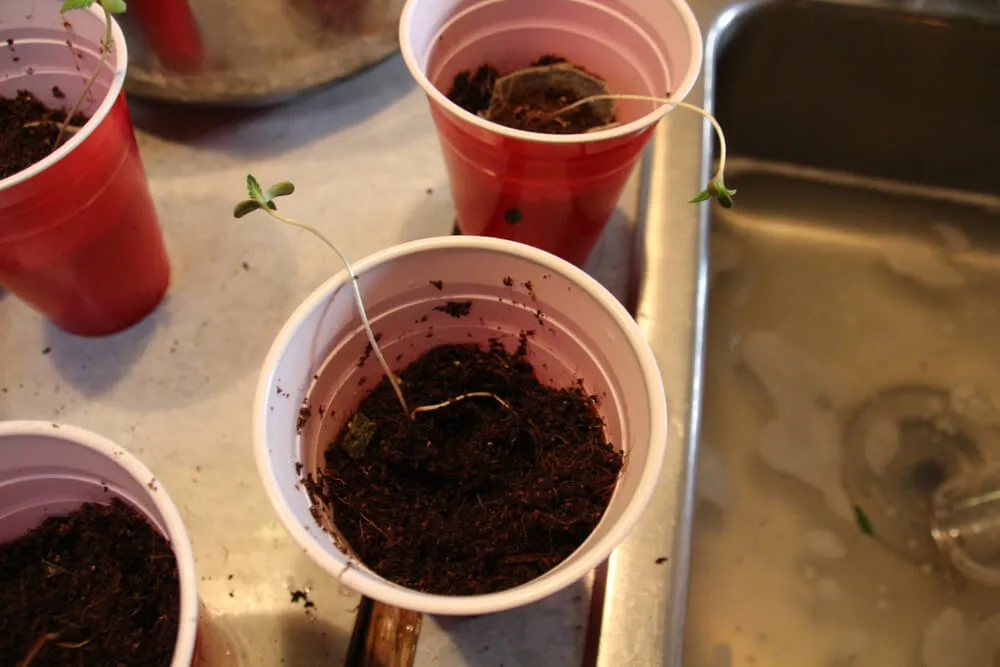
Seedlings tend to stretch and become lanky when they don’t have enough light or are too far away from the source. Bringing the light source a little closer (6 inches / 15 cm above the canopy) should help them stabilize and strengthen their stems. Propping them up with a small stick will also keep them from falling over and aid in their recovery.
How to avoid seedlings damping off
Damping off seedlings, or stem rot, is a condition that can take many growers by surprise as it can take out a healthy plant very quickly. It is caused by seed- and soil-born fungi either at the soil line, underground or even at the crown of the seedling. If your soil is warm, rich in nitrogen and stays wet for an extended period, fungi are ready to pounce. The lower part of plant stalks near the soil line turns yellowish-brown early on, eventually turning into soft, reddish-brown dead tissue, which makes your plant simply fall over. While the roots are unaffected, the rest of your plant unfortunately is beyond repair. Unfortunately, if this is the case, you can only kiss the affected seedling goodbye and remove it from your garden to limit the spread of fungi. Damping off can be avoided by keeping an eye on temperature and humidity and making sure seedlings aren’t over-watered. Since this occurs mostly in soil, make sure you have a sterilized medium or use a 0.5% solution of hydrogen peroxide to take out any potential fungal infections.
Summary
Seedlings can be a tricky beast as they are very delicate and sensitive. Like vegetative plants, they need just the right amount of humidity, light and heat, though given their size they don’t need all that much. By keeping an eye on them and paying attention to their reactions, you can prevent diseases and pests and make it successfully to the vegetative phase of growth. Growing cannabis seedlings successfully is just one more step in your journey of becoming a true cannabis plant-whisperer.
